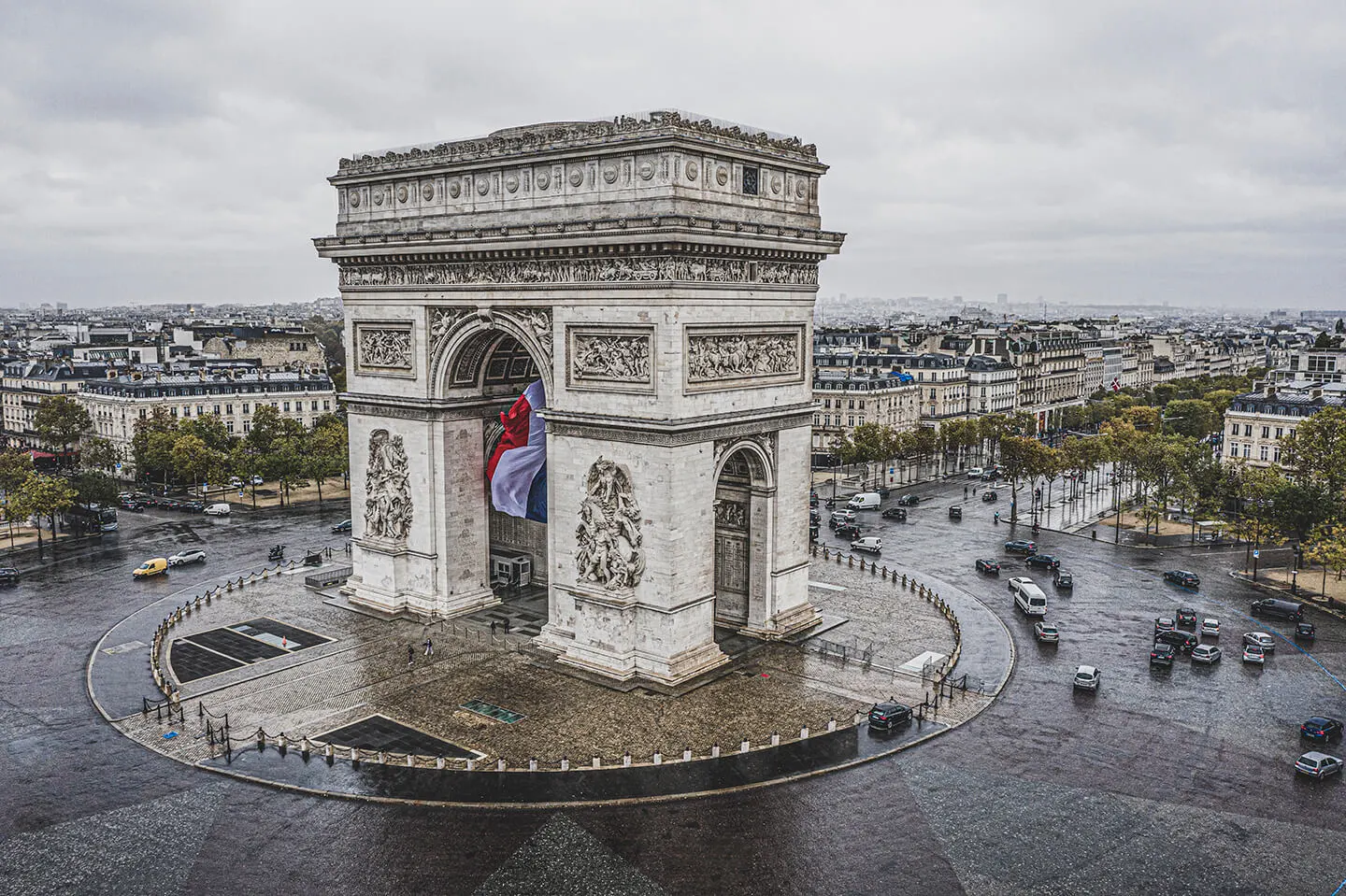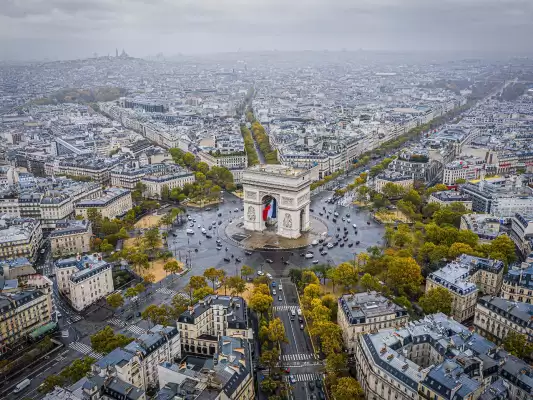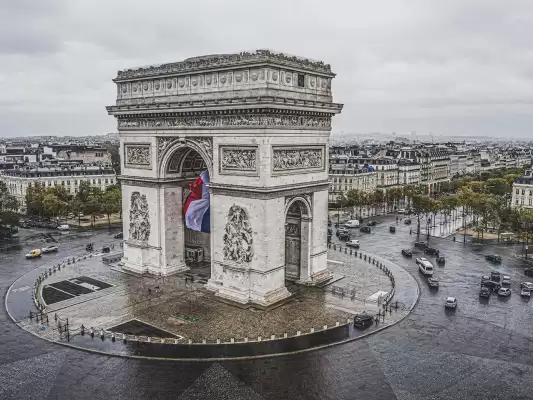In this free full guide, you will learn about the Triumphal Arch (Arc de Triomphe), located in the center of Paris, France. Join us on an unforgettable journey through the history, architecture, and secrets of this inspiring monument.
Arc de Triomphe – Free Full Guide
Editor’s Choice
The Eiffel Tower in Paris – Free Audio Guide
Milan’s Cathedral Free Audio Guide
Colloseum Free Audio Guide
The Arc de Triomphe de l’Étoile (in English – “the Triumphal Arch of the Star”) is one of the most famous monuments in Paris, France. It stands at the western end of the Champs-Élysées at the center of Place Charles de Gaulle on the right bank of the river Seine. It was formerly named “Place de l’Étoile” (or “Place of Star”) because of the juncture formed by its twelve radiating avenues.
The location of the arc and the plaza is shared between three districts of Paris, 16th (south and west), 17th (north), and 8th (east). The Arc de Triomphe honors those who fought and died for France in the French Revolutionary and Napoleonic Wars, with the names of all French victories and generals inscribed on its inner and outer surfaces. Beneath its vault lies the Tomb of the Unknown Soldier from World War 1.
The Arc de Triomphe was designed by Jean Chalgrin in 1806; its iconographic program pits heroically nude French youths against bearded Germanic warriors in chain mail. It set the tone for public monuments with triumphant patriotic messages.
Inspired by the Arch of Titus in Rome, Italy, the Arc de Triomphe has an overall height of 50 meters (164 feet), width of 45 meters (148 feet), and depth of 22 meters (72 feet). It equals a 16-story building.
The large vault is 29.19 meters (95.8 feet) high and 14.62 meters (48 feet) wide. The smaller transverse vaults are 18.68 meters (61.3 feet) high and 8.44 meters (27.7 feet) wide.
Three weeks after the Paris victory parade in 1919 (marking the end of hostilities in World War 1), Charles Godefroy flew his Nieuport biplane under the arch’s primary vault, with the event captured on newsreel.
Paris’s Arc de Triomphe was the tallest triumphal arch until the completion of the Monumento a la Revolución in Mexico City in 1938, which is 67 meters (220 feet) high. The Arch of Triumph in Pyongyang, completed in 1982, is modeled on the Arc de Triomphe and is slightly taller at 60 meters (197 feet). The Grande Arche in La Défense near Paris is 110 meters high. Although it is not named an Arc de Triomphe, it has been designed on the same model and from the perspective of the Arc de Triomphe. It qualifies as the world’s tallest arch.
The history of the Arch is exciting. It was commissioned in 1806, after the victory at Austerlitz by Emperor Napoleon at the peak of his fortunes. Laying the foundations alone took two years and, in 1810, when Napoleon entered Paris from the West with his new bride, Archduchess Marie-Louise of Austria, he had a wooden mock-up of the completed arch constructed. The architect, Jean Chalgrin, died in 1811 and the work was taken over by Jean-Nicolas Huyot.
During the Bourbon Restoration, construction was halted, and it would not be completed until the reign of King Louis-Philippe, between 1833 and 1836, by the architects Goust, then Huyot, under the direction of Héricart de Thury.
The final cost was reported at about 10 million francs (equivalent to an estimated 65 million euros or 75 million US dollars in 2020).
On 15 December 1840, brought back to France from Saint Helena, Napoleon’s remains passed under it on their way to the Emperor’s final resting place at Les Invalides.
Before burial in the Panthéon, the body of Victor Hugo was displayed under the Arc on the night of 22 May 1885.
In 1916, the sword carried by the Republic in the Marseillaise relief broke off on the day, it is said, that the Battle of Verdun began. The relief was immediately hidden by tarpaulins to conceal the accident and avoid any undesired ominous interpretations. On the 7th of August 1919, Charles Godefroy successfully flew his biplane under the Arc.
Following its construction, the Arc de Triomphe became the rallying point of French troops parading after successful military campaigns and for the annual Bastille Day military parade. Famous victory marches around or under the Arc have included the Germans in 1871, the French in 1919, the Germans in 1940, and the French and Allies in 1944 and 1945.
After the interment of the Unknown Soldier, however, all military parades have avoided marching “through” the actual arch. The route taken is up to the arch and then around its side, out of respect for the tomb and its symbolism. Both Hitler in 1940 and de Gaulle in 1944 observed this custom.
By the early 1960s, the monument had grown very blackened from coal soot and automobile exhaust, and during 1965–1966 it was cleaned through bleaching.
In the prolongation of the Avenue des Champs-Élysées, a new arch, the Grande Arche de la Défense, was built in 1982, completing the line of monuments that forms Paris’s Axe historique.
In 1995, the Armed Islamic Group of Algeria placed a bomb near the Arc de Triomphe which wounded 17 people as part of a campaign of bombings. The Arc itself didn’t get any damage.
On 12 July 1998, when France won the FIFA World Cup by defeating Brazil 3 – 0 at the Stade de France, images of the players (including Zinedine Zidane), and their names along with celebratory messages were projected onto the arch.
In late 2018, the Arc de Triomphe suffered acts of vandalism as part of the Yellow Vests protests. The vandals sprayed the monument with graffiti and ransacked its small museum. But it was later cleaned by Parisian authorities.
Now, let’s talk about the design and what you can see on the Arc itself.
Jean Chalgrin made the main design. It is a Neoclassical version of ancient Roman architecture.
Most sculptures are made by famous French sculptors: Jean-Pierre Cortot; François Rude; Antoine Étex; James Pradier, and Philippe Joseph Henri Lemaire. These sculptures are treated as independent trophies applied to the vast ashlar masonry masses.
The four sculptural groups at the base of the Arc are The Triumph of 1810 (by Cortot), Resistance and Peace (both by Antoine Étex), and the most renowned of them – Departure of the Volunteers of 1792 (commonly called La Marseillaise).
In the attic above the richly sculptured frieze of soldiers are 30 shields engraved with the names of major French victories in the French Revolution and Napoleonic wars.
The inside walls of the monument list the names of 660 people, among which are 558 French generals of the First French Empire. The names of those generals killed in battle are underlined. Also inscribed, on the shorter sides of the four supporting columns, are the names of the major French victories in the Napoleonic Wars. The battles that took place in the period between the departure of Napoleon from Elba to his final defeat at Waterloo are not included.
Inside the monument, you can see the permanent exhibition, conceived by artist Maurice Benayoun and architect Christophe Girault, which opened in February 2007.
Beneath the Arc, you can see the Tomb of the Unknown Soldier from World War 1. Interred on Armistice Day 1920, an eternal flame burns in memory of the dead who were never identified (now in both world wars).
A ceremony is held at the Tomb of the Unknown Soldier every 11 November on the anniversary of the Armistice of November 11th, 1918 signed by the Entente Powers and Germany in 1918. It was originally decided on 12 November 1919 to bury the unknown soldier’s remains in the Panthéon, but a public letter-writing campaign led to the decision to bury him beneath the Arc de Triomphe. The coffin was put in the chapel on the first floor of the Arc. The slab on top bears the inscription: “Here rests a French soldier who died for the Fatherland, 1914–1918”.
As it was mentioned before, there are four main sculptural groups on each of the Arc’s pillars.
The 1st one is the “Le Départ de 1792” (or “La Marseillaise”), by François Rude. The sculptural group celebrates the cause of the French First Republic during the 10 August uprising. Above the volunteers is the winged personification of Liberty. This group served as a recruitment tool in the early months of World War 1 and encouraged the French to invest in war loans in 1915–1916.
The 2nd one is the “Le Triomphe de 1810”, by Jean-Pierre Cortot, which celebrates the Treaty of Schönbrunn. This group features Napoleon, crowned by the goddess of Victory.
The 3rd one is the “La Résistance de 1814”, by Antoine Étex, which commemorates the French Resistance to the Allied Armies during the War of the Sixth Coalition.
And the 4th one is the “La Paix de 1815”, by Antoine Étex commemorates the Treaty of Paris, which concluded in that year.
Six reliefs sculpted on the façades of the Arch represent important moments of the French Revolution and of the Napoleonic era:
General Marceau’s burial: Southern façade, right;
The Battle of Aboukir: Southern façade, left;
The Battle of Jemappes (Eastern façade);
The Battle of Arcole (Northern façade, right);
The Fall of Alexandria (Northern façade, left);
And The Battle of Austerlitz (Western façade).
From the inside of the arc, you can find 30 names of the battles engraved on the attic and 96 battle names engraved on the inner façades, under the great arches.
Also, you can find the names of 660 military leaders who served during the French First Republic and the First French Empire engraved on the inner façades of the small arches. Underlined names signify those who died on the battlefield.
The great arcades are decorated with allegorical figures representing characters in Roman mythology (by James Pradier).
The ceiling is decorated with 21 sculpted roses.
And there are several plaques at the foot of the monument.
The Arc de Triomphe is accessible by the public train (called RAR) and Métro, with an exit at the Charles de Gaulle–Étoile station. Because of heavy traffic on the roundabout of which the Arc is the center, it is recommended that pedestrians use one of two underpasses located at the Champs Élysées and the Avenue de la Grande Armée. A lift will take visitors almost to the top – to the attic, where a small museum contains large models of the Arc and tells its story from the time of its construction. Another 40 steps remain to climb to reach the top, the terrasse, from where one can enjoy a panoramic view of Paris. Access to the top of the arc is not free, therefore you need to buy tickets in advance.
As we approach the end of our journey, I want to extend my heartfelt gratitude to each and every one of you for joining us today. Your likes, comments, and subscriptions mean the world to us and encourage us to keep creating exciting videos like this.
Interesting facts and takeaways.
The Arc de Triomphe in Paris is an iconic monument that holds a rich history and several intriguing facts. Here are some of the most exciting and interesting facts about the Arc de Triomphe:
- The Arc de Triomphe was commissioned by Napoleon Bonaparte in 1806 after his victory at Austerlitz, with the intention to honor the French army. It was meant to be a symbol of his military triumphs and the glory of the French nation.
- The Arc de Triomphe stands at an impressive height of 50 meters (164 feet). Its size and grandeur make it one of the most remarkable triumphal arches in the world.
- Intricate Sculptures: The monument features intricate sculptures that adorn its façades. These sculptures depict various scenes from French military history, including battle victories, allegorical figures, and military symbols.
- The Arc serves as the resting place for the Tomb of the Unknown Soldier. The tomb was added in 1921 and contains the remains of an unidentified soldier who died during World War 1.
- In addition to the Tomb of the Unknown Soldier, there is an eternal flame that burns beneath the arch. It was rekindled on November 11, 1923, and has continued to burn ever since.
- The Arc de Triomphe was not completed during Napoleon’s reign. Construction was halted due to various political and financial reasons. It was finally completed in 1836.
- It is situated at the western end of the Champs-Élysées avenue. From the top of the monument, visitors can enjoy a panoramic view of the famous avenue and the surrounding Parisian landmarks.
- Visitors can climb to the top of the Arc de Triomphe for a stunning view of Paris. The rooftop offers breathtaking panoramas of the city, including iconic landmarks like the Eiffel Tower and the Louvre.
- Throughout history, the Arc has been the site of numerous military parades and processions, including the famous Bastille Day parade held annually on July 14th.
- It has witnessed many historical events, including the occupation of Paris by Nazi Germany during World War II. Despite threats of destruction from Adolf Hitler, the monument survived unscathed, standing as a symbol of French resilience and pride.




